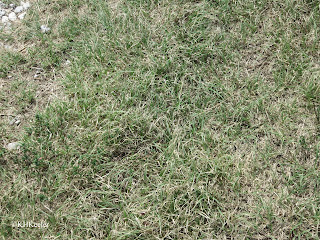 |
stand of buffalo grass, Buchloë dactyloides,
grass family, Poaceae. Area is about 1 square yard. |
Buffalograss is one of my favorite plants. Grasses get walked over a lot, with people not even trying to tell them apart. One of buffalo grass's strengths might be recognizability. Once you learn what it looks like, it is easily recognized. The leaves are narrow green ribbons. The plant sends out runners which root and let it spread. It never grows more than 8-10" (20 cm) tall. You never have to mow a buffalo grass lawn.
 |
| herd of bison (old bad photo) |
For clarity I should state that I'm talking about
Buchloë dactyloides, the buffalo grass that is native to the high plains of North America. There is a tall (3', 1 m) grass in southern Africa called foxtail buffalo grass which I have seen labelled "buffalo grass" online. I don't mean that buffalo grass. And, apparently South Africa and Australia call Stenotaphrum secundatum buffalo grass or buffalo lawn grass. In the U.S., the usual name for S. secundatum is St. Augustine grass. I don't mean that buffalo grass either. I mean the North American native buffalo grass Buchloë dactyloides.
 |
buffalo grass, Buchloë
dactyloides,
closer view, area less than 1 square
foot. The grass blades are about 4"
tall. |
(I have no idea why there are dots, an umlaut, over the e. There are two syllables there, though: Buk lo ee).
The "buffalo" in the name of the buffalo grass refers to the American bison,
Bison bison, popularly called the buffalo. Buffalo grass,
Buchloë dactyloides, apparently owes its distribution to the bison. And it contributed to the bison's success. In sum, they have a mutualistic relationship aiding both, even though they are grass and grazer.







